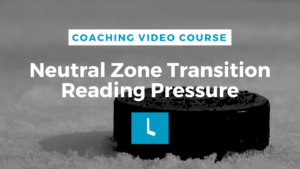 As we explore the hockey tight turn in detail, I encourage you to think about your body’s reaction in an event that is out of your comfort zone. Our reactionary nervous system often makes our bodies do funny things. When I ski or snowboard and hit a jump, my brain tells my legs to straighten, as if telling my feet they need to make contact with the ground as soon as possible.
As we explore the hockey tight turn in detail, I encourage you to think about your body’s reaction in an event that is out of your comfort zone. Our reactionary nervous system often makes our bodies do funny things. When I ski or snowboard and hit a jump, my brain tells my legs to straighten, as if telling my feet they need to make contact with the ground as soon as possible.
Video analysis would reveal that I should, “hold my form, tuck my legs, relax, everything will be fine!” yet for some reason, our human instincts go against the laws of physics that would otherwise allow us to succeed. In the skating portion of our sessions, we often focus our instruction on various types of tight turns used in hockey (tight turn, punch turn, transitional pivot, etc). Throughout these sessions, 3 common mistakes in a hockey tight turn keep popping up at every level of player we teach.
1) Tight Turn Mistake #1: Players lean back on their heels:
Watch a hockey player tight turn with all the weight transferring to the heels in both skates. Ice chips fly a foot in the air, the skates crunch through the ice, and the hockey player quickly decelerates to a near-standstill. I like to tell kids that the sound they hear, and the ice they see flying in the air actually require energy to create. This is high school physics. Creating the crunching sound and shooting ice chips in the air requires use of this energy, consequently the skater can’t use that energy to keep momentum and speed in the tight turn.
In grade 10 or 11 physics, I learned there is a finite amount of energy available. In this instance the kinetic energy in the speed of the skater is being transferred into sound energy and into making the ice fly into the air. If my Physics is a bit off, I apologize. The point is… keep the weight evenly distributed throughout the center of the blade, as long as possible through the tight turn. Feel the vibrations throughout the skate blade, rather than just the heel.
2) Tight Turn Mistake #2: Players stand too tall:
A tall tree in the wind will blow over quite easily. A shrub on the other hand, will last through a Prairie storm. Centripetal force is the key bit of physics at play in a tight turn. Turning sharply is nearly impossible if the center of the skater’s gravity is too high. Keep your bum low to the ice, your ankles flexed so that your shins press against the tongues of your skates, and keep your chest directly above your thighs. Check out the feature image of Daniel Sedin in this post. His tight turns, like his brother, are always so intentional. He distributes his weight evenly throughout his blades (#1), he maintains a deep knee bend (#2), and #3…
3) Tight Turn Mistake #3: Players walk a tightrope:
Imagine a tightrope walker, with one foot in front of the other. Now envision a bow legged cowboy riding a horse. Or a Sedin twin. In a poorly executed hockey tight turn, positioning one foot in front of the other gives the skater a very narrow foundation, allowing the player to be pushed over with the slightest of ease. A wide stance (#3), with chest above thighs (#2), edges planted firmly in the ice, shoulders forward, weight evenly distributed along the blades (#1), and shoulders directly above hips, is a very strong and well balanced tight turn. Come on, just try to knock me over now!
Tight turn and other great skating, puck skill and tactical tutorials:
We love teaching the game both on and off the ice. Our digital platforms allow us to share our decades of expertise with coaches and recreational players around the world. Literally. From Mongolia, to China, New Zealand, Hungary, Belgium, England, and here in North America, just to name a few.
Download some of our video tutorials here.
Stream them all as a student in our coaching course here.
Teaching Cues for a great Tight Turn in hockey:
- Wide stance
- Get off your heels – balance your weight
- Chest above thighs
- Shoulders over hips
- Rotate the head and upper body in the direction of the turn
- One inside and one outside edge
- Practice.





